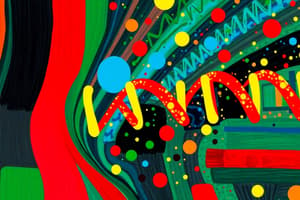Podcast
Questions and Answers
What does the multiplicity of a signal in NMR spectroscopy indicate?
What does the multiplicity of a signal in NMR spectroscopy indicate?
- The acidity or basicity of the compound
- The connectivity of protons in the molecule (correct)
- The number of protons in the molecule
- The molecular weight of the compound
The n+1 rule states that a proton with three equivalent neighbors will be split into four lines.
The n+1 rule states that a proton with three equivalent neighbors will be split into four lines.
True (A)
In NMR spectroscopy, what does the term 'chemical shift' refer to?
In NMR spectroscopy, what does the term 'chemical shift' refer to?
The extent to which neighboring functional groups withdraw electrons.
The integration of the lines in an NMR spectrum indicates the number of ________ contributing to that signal.
The integration of the lines in an NMR spectrum indicates the number of ________ contributing to that signal.
Match the following terms to their definitions in the context of NMR spectroscopy:
Match the following terms to their definitions in the context of NMR spectroscopy:
How many lines will a proton with no equivalent neighbors appear as in NMR spectroscopy?
How many lines will a proton with no equivalent neighbors appear as in NMR spectroscopy?
The integration of each line in a signal is always equal in NMR spectroscopy.
The integration of each line in a signal is always equal in NMR spectroscopy.
What is the Index of Hydrogen Deficiency used for in spectral analysis?
What is the Index of Hydrogen Deficiency used for in spectral analysis?
What is the molecular formula of the compound discussed?
What is the molecular formula of the compound discussed?
The Index of Hydrogen Deficiency (IHD) for the compound is 1.
The Index of Hydrogen Deficiency (IHD) for the compound is 1.
What type of integration and multiplicity is observed in the H-NMR assignment for the CHCH3 group?
What type of integration and multiplicity is observed in the H-NMR assignment for the CHCH3 group?
The chemical shift for the CH3 group in the 13C-NMR assignment is at __________.
The chemical shift for the CH3 group in the 13C-NMR assignment is at __________.
Match the following NMR characteristics with their corresponding descriptions:
Match the following NMR characteristics with their corresponding descriptions:
What is the molecular formula of Unknown A?
What is the molecular formula of Unknown A?
The presence of a C=O group is indicated by an absorption peak at 1741 cm-1.
The presence of a C=O group is indicated by an absorption peak at 1741 cm-1.
What does IHD stand for in the context of NMR analysis?
What does IHD stand for in the context of NMR analysis?
The chemical shift at approximately _____ ppm indicates that a proton is attached to an electronegative atom like O, N, or halide.
The chemical shift at approximately _____ ppm indicates that a proton is attached to an electronegative atom like O, N, or halide.
Match the following molecular features with their corresponding values:
Match the following molecular features with their corresponding values:
Which of the following is the likely signal multiplicity for the protons in CH3-CH2 group?
Which of the following is the likely signal multiplicity for the protons in CH3-CH2 group?
The IHD value for Unknown B is 2.
The IHD value for Unknown B is 2.
How many distinct signals would you expect to find for Unknown A in the 13C-NMR spectrum?
How many distinct signals would you expect to find for Unknown A in the 13C-NMR spectrum?
In NMR, a _______ indicates that there are no neighboring protons influencing the chemical shift.
In NMR, a _______ indicates that there are no neighboring protons influencing the chemical shift.
For Unknown A, which of the following statements is incorrect?
For Unknown A, which of the following statements is incorrect?
Flashcards are hidden until you start studying
Study Notes
NMR Spectroscopy
- Multiplicity of a signal tells us about functional groups connected
- Doublet signal implies 1 adjacent proton
- Triplet signal implies 2 adjacent protons
- n+1 Rule - A proton with n equivalent neighbours will be split into n+1 lines
- Integration of lines in signal is not always equal
- Coupling constant (J) - separation of lines in the signal
Summary of 1H-NMR Spectroscopy
- Chemical Shift - How electron withdrawing are neighboring functional groups?
- Integration - How many protons contribute to each signal (relates to symmetry)
- Multiplicity - How are the signals split?
Summary of 13C-NMR Spectroscopy
- Chemical Shift - How electron withdrawing are neighboring functional groups?
- Integration - N/A
- Splitting - N/A
Activity 3 - Unknown A
- Molecular Formula: C4H8O2
- Index of Hydrogen Deficiency (IHD): 1
- Reference: C4H10
- Calculated: (10-8)/2 = 1
- IR Data:
- 2984 cm-1 - presence of C-H bond
- 1741 cm-1 - presence of C=O group
- 1H-NMR Data:
- Chemical Shift ~ 1.2 ppm - CH2CH3
- Chemical Shift ~ 2.0 ppm - O=C-CH3
- Chemical Shift ~ 4.2 ppm - CH2CH3
- 13C-NMR Data:
- Chemical Shift ~ 15 ppm - CH2CH3
- Chemical Shift ~ 20 ppm - CH3
- Chemical Shift ~ 60 ppm - CH2
- Chemical Shift ~ 170 ppm - C=O
- Proposed Structure: Ethyl Acetate (CH3COOCH2CH3)
Activity 3 - Unknown B
- Molecular Formula: C2H4Cl2
- Index of Hydrogen Deficiency (IHD): 0
- 1H-NMR Data:
- Chemical Shift ~ 2.0 ppm - CHCH3
- Chemical Shift ~ 5.9 ppm - CHCH3
- 13C-NMR Data:
- Chemical Shift ~ 15 ppm - CH3
- Chemical Shift ~ 70 ppm - CH
- Proposed Structure: 1,1-Dichloroethane (CH3CHCl2)
Studying That Suits You
Use AI to generate personalized quizzes and flashcards to suit your learning preferences.




